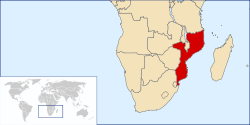Overseas Province of Mozambique
| Mozambique Portuguese East Africa |
||||||||||
|
Moçambique África Oriental Portuguesa |
||||||||||
|
Colony and overseas province; State of the Portuguese Empire |
||||||||||
|
||||||||||
|
Anthem "Hymno Patriótico" (1808–26) Patriotic Anthem "Hino da Carta" (1826–1911) Hymn of the Charter "A Portuguesa" (1911–75) The Portuguese |
||||||||||
|
Portuguese East Africa
|
||||||||||
| Capital | Lourenço Marques | |||||||||
| Languages | Portuguese | |||||||||
| Political structure | Colony | |||||||||
| Head of state | ||||||||||
| • | 1498–1521 | King Manuel I of Portugal | ||||||||
| • | 1974–75 | President Francisco da Costa Gomes | ||||||||
| Governor-general | ||||||||||
| • | 1609–11 | Sancho de Tovar (first) | ||||||||
| • | 1974–75 | Vítor Manuel Trigueiros Crespo (last) | ||||||||
| Captain-general | ||||||||||
| • | 1569–73 | Francisco Barreto (first) | ||||||||
| • | 1607–09 | Estêvão de Ataíde (last) | ||||||||
| Historical era | Imperialism | |||||||||
| • | Established | 1498 | ||||||||
| • | Fall of Portuguese Empire | 25 June 1975 | ||||||||
| Area | ||||||||||
| • | 1967 | 784,955 km2 (303,073 sq mi) | ||||||||
| Population | ||||||||||
| • | 1967 est. | 7,300,000 | ||||||||
| Density | 9/km2 (24/sq mi) | |||||||||
| Currency |
Mozambican real (until 1914) Mozambican escudo (1914–75) |
|||||||||
|
||||||||||
| Today part of |
|
|||||||||
Portuguese Mozambique (Portuguese: Moçambique) or Portuguese East Africa (África Oriental Portuguesa) are the common terms by which Mozambique is designated when referring to the historic period when it was a Portuguese overseas territory. Portuguese Mozambique constituted a string of Portuguese colonies and later a single Portuguese overseas province along the south-east African coast, which now forms the Republic of Mozambique.
Portuguese trading settlements and, later, colonies, were formed along the coast from 1498, when Vasco da Gama first reached the Mozambican coast. Lourenço Marques explored the area that is now Maputo Bay in 1544. He settled permanently in present-day Mozambique, where he spent most of his life, and his work was followed by other Portuguese explorers, sailors and traders. Some of these colonies were handed over in the late 19th century for rule by chartered companies such as the Mozambique Company (Companhia de Moçambique), which had the concession of the lands corresponding to the present-day provinces of Manica and Sofala, and the Niassa Company (Companhia do Niassa), which had controlled the lands of the modern provinces of Cabo Delgado and Niassa. In 1951 the colonies were combined into a single overseas province under the name Moçambique as an integral part of Portugal. Most of the original colonies have given their names to the modern provinces of Mozambique.
Mozambique, according to official policy, was not a colony at all but rather a part of the "pluricontinental and multiracial nation" of Portugal. Portugal sought in Mozambique, as it did in all its colonies, to Europeanise the local population and assimilate them into Portuguese culture. Lisbon also wanted to retain the colonies as trading partners and markets for its goods. African inhabitants of the colony were ultimately supposed to become full citizens with full political rights through a long development process. To that end, segregation in Mozambique was minimal compared to that in neighbouring South Africa. However, paid forced labour, to which all Africans were liable if they failed to pay head tax, was not abolished until the early 1960s.
...
Wikipedia



